
Smallbrook Queensway is a boulevard in the center of Birmingham, Britain’s second-largest city, located just around the corner from New Street railway station, one of the United Kingdom’s busiest. It is a spectacular piece of urban scenery—strongly modernist, sleek, and dramatic—an effect created by a huge but low-rise building called the Ringway Centre, designed in 1962 by architect James Roberts and later deemed, by the Birmingham Pevsner architectural guide, as “the best piece of mid-20th-century urban design in the city.”
Curved, the building swoops suddenly downhill, with a sculptural concrete surface of louvers and abstract reliefs, giving it the effect of go-faster stripes. It ends in a two-level underpass and two high-rise public housing blocks, also by Roberts, with the tight streets of Chinatown just behind. Now vacant and condemned, it remains an unusual structure and the epitome of “carchitecture,” designed to make for an equally pleasurable experience whether walking or driving by.
The Ringway Centre is slated for demolition—it’ll be replaced by giant glass, mixed-use towers—as are many of central Birmingham’s modernist structures, from the 1950s to the 1970s, that signal a time when the city took risks to transform itself into a futuristic, multilevel metropolis. Today, the city’s reputation, locally and globally, is one of chaos. Due to some bizarre misunderstandings over a highly publicized (and substantially manufactured) schools scandal, Birmingham is often considered abroad as a no-go area for non-Muslims, a notion most locals find hilariously inaccurate. Within Britain, where I live, it has become known for a descent into a financial crisis, caused by 15 years of austerity enforced by the central government, and the council’s drastically mismanaged transition to a new computer system, making the city effectively bankrupt.
It is a city in trouble, and the solution to save it—a development-at-all-costs approach to the urban landscape—is appalling. When I visit, three or four times a year, any compelling building I find will likely have fallen into dereliction or erased the next time I stop by. Cheap, nasty, and above all, facile, new construction is perhaps best symbolized by the nearby New Street station, a flashy superstructure designed to hide a bunker-like 1960s building. It is little more than a giant billboard concealing a sagging tent, a failed shopping mall, and a baffling system of circulation.
As a result, conservation and enthusiasm for modern architecture have often merged here in unexpected ways, as campaigners struggle to save the aggressive concrete edifices that replaced Victorian townscapes 60 years ago. This past February and last year, on the two occasions the city council met to vote on demolishing the Ringway Centre, they were surprised to find large crowds outside, demanding the retention of the sort of lumbering, carbon-intensive, car-centric building that conservationists typically oppose.
Underlying their position is a counterintuitive view of urban development: For the campaigners, the path to revitalization isn’t knocking everything down and starting over again. It’s about identifying and preserving the best of what’s already there, and using that knowledge to inform the improvements that happen next.

One person at the heart of the campaign to save Birmingham’s Brutalist architecture is Mary Keating. When I spoke to her, she was just back from giving a courier an application for judicial review of the council’s narrowly approved decision to demolish the Ringway Centre.
A co-founder of the Brutiful Birmingham action group, formed in 2015, her group’s articles, full of enthusiasm for mid-20th century buildings, regularly appear in the local newspaper and were collected into the 2022 book Birmingham: The Brutiful Years, illuminating the impacts of the area’s architecture on history and people’s lives.
Keating and her colleagues constantly point out the overlooked quality of detail in these structures: richly modeled concrete surfaces (like the strips and louvers on the Ringway Centre), mosaic panels (such as the artwork by John Piper on John Madin’s Chamber of Commerce building), or the ornate bronze doors at the entrance of the now-demolished National Westminster Bank. Far from inferior and interchangeable, buildings celebrated by the Brutiful campaigners demand public interaction as well as a closer look, and consider the pedestrian as much as the driver. In one of its rare successes, the group helped get the Hockley flyover underpass, a giant sculptural work by William Mitchell under an inner-city motorway interchange, added to the heritage list, saving it from threatened demolition.
But the Ringway campaign, Keating points out, seems to have little hope of saving the building on an appeal to aesthetics. Now, she says, “we’re only going on embodied carbon”—that is, on the destructive environmental impacts of destroying the building and pouring loads of concrete to build a new one. (Perplexingly, Birmingham has pledged to reduce its carbon emissions to zero by 2030.)
That’s not to say that Birmingham’s urban framework—with its lack of public transport, sprawling suburbs, and overdeveloped center—is all great. According to Andy Foster, an architectural historian and former Labour councilor in the city, Birmingham is “haunted” by the dream of becoming a “new Chicago.” It suburbanized early, shifting in the 1930s to a city that made cars, where workers drove cars, and where new housing was designed around cars. From then until the 1970s, its development was dominated by the city engineer Herbert Manzoni, who plowed multilane roads into and around its center and, unlike the more interventionist, socialist planners of the era, let the market do the rest.
One local writer, who did not want to be named, calls Manzoni a “pound shop Robert Moses,” and like Moses, Manzoni was not a qualified architect or planner, and never held elected office. The same writer told me that Birmingham’s obsession with America intersected with its inferiority complex vis-à-vis the well-preserved medieval towns that surround it—which explains why Birmingham’s city authorities often display indifference to its historic architecture that, whether Arts and Crafts (seen in its suburbs) or Brutalist, is often cranky and odd. Much of it is intriguing, but rarely is any of it pretty-pretty.
Today’s developers often target the few buildings of real quality from Manzoni’s era because of the lucrative sites on which they stand. They include several structures by architect John Madin, most prominently Pebble Mill, a modernist television production studio; the Post and Mail building, a Lever House–inspired glass tower that housed a local newspaper; the National Westminster Bank, an angular and powerful Brutalist skyscraper; and the Birmingham Central Library, a symbol of British Brutalism that was pulled down and replaced with a dull office block and a new library. (Immediately upon completion, it had to cut its opening hours to six hours a day due to the period’s austerity policy.) Most of these buildings were both international and local: confident, modern structures that housed institutions native to the city.
Parts of Birmingham’s urban environment symbolize another key aspect of its roller-coaster history. During much of the 20th century, under Conservative rule, the city had a deep pride in its legacy of pioneering municipal socialism, with its empire of publicly owned gas, water, transport, schools, college, parks, and housing systems. Public services, recalls Foster, were simply “what Birmingham did,” running itself as a progressive business in aid of its people. But the collapse of Birmingham’s industry in the 1980s, and the loss of skilled jobs that went with it, threw the city into a crisis from which it never quite recovered.
That focus on service briefly resurfaced. In the 1990s, Foster says, some efforts were made to break with the American model of road-centric development, and create a more European, walkable, democratic city center. Much of this, he says, is owed to one council leader, Labour’s Dick Knowles, who had a personal interest in architecture. (Birmingham city council is run by a cabinet system, in which 10 councilors effectively make the decisions for a city of a million people.) His work culminated in a new Victoria Square, a series of fountains, pools, and set pieces around its grand 19th-century civic buildings; and Brindleyplace, a series of mid-rise office buildings around canals, focused on a conserved Arts and Crafts school that was transformed into a home for the avant-garde Ikon Gallery. Manzoni’s inner-city motorways were progressively dismantled, piece by piece. But when the council shifted to the right, around 1999, Birmingham’s insensitive, growth-at-all-costs development approach abruptly returned.

If Birmingham Council once saw itself as a social resource, it now sees itself as a development agency, focused on steamrolling opponents as a means to bringing jobs and new construction to the city. Keating, of the Brutiful Birmingham group, concedes some of this: The city needs jobs and housing—though, she notes, the homes being built seldom serve those on Birmingham’s public-housing waiting list, instead catering largely to a transient student population.
She is aware that there’s an irony in fighting for the preservation of the remnants of the last time Birmingham destroyed and rebuilt itself. But for Keating, saving the Ringway Centre “is about a bigger issue”: the question of who the city is actually for. The Centre is a case study, she insists, and if the campaigners change its trajectory, they’ll prove that civic action actually makes a difference in Birmingham. A conscious choice on the part of Birmingham to stop the endless cycle of development at all costs can give it a chance to take a breather, and to consider how its buildings might best serve its residents.
What remains of Birmingham’s bold experimentation should be preserved on its own merits, like its tourist-oriented Jewellery Quarter, which contains 19th-century metalworking factories and workshops. Such artifacts can also be an index of tried, tested, and failed modes of city-building. Mitchell’s Hockley underpass, for instance, is a thrilling piece of art fused with car infrastructure, but it would be exceptionally unwise for a city to embark on anything similar now.
Birmingham, and other such places in peril, could become models for urban revitalization by interrogating existing structures and using them to propose new answers to the questions of the 2020s. What might a 1960s megastructure in the 20th century be used for, and by whom? Who ought to own and manage such buildings? What do you do with areas that have been turned over to people rather than cars, and how do you make them work for everyone? What happens to a city when growth no longer works?